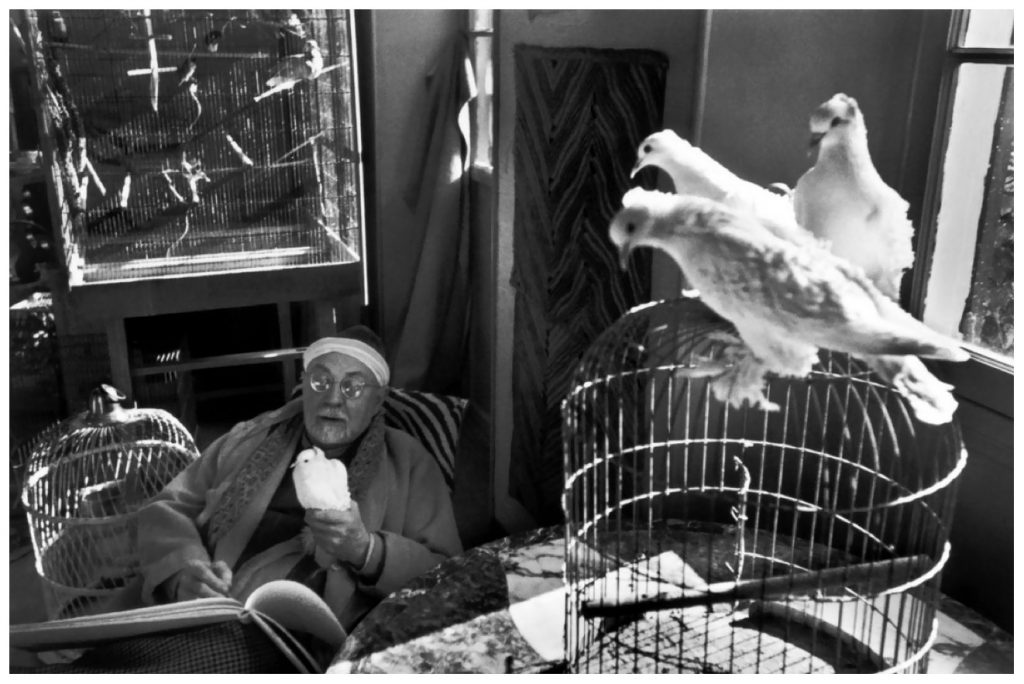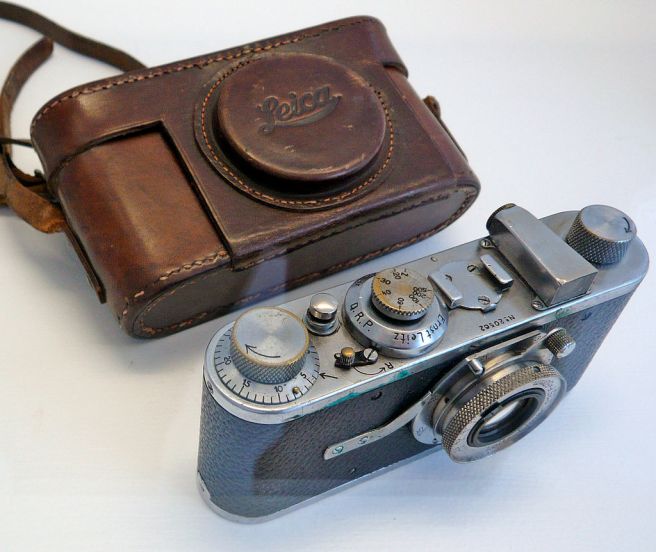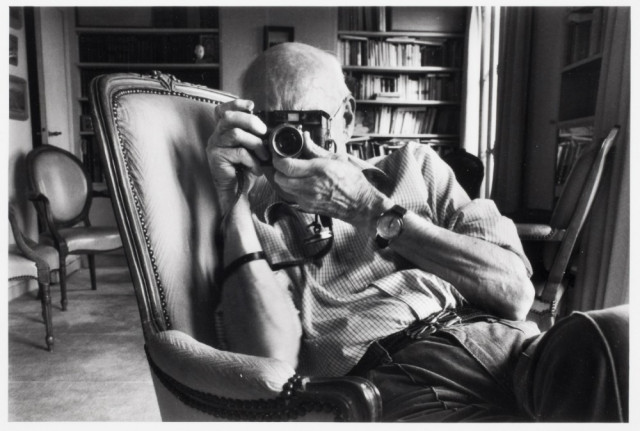By Bill Dobbins
www.billdobbinsphotography.com Using a small and unobtrusive camera like the Leica made images like this possible. BELGIUM. Brussels. 1932. © Henri Cartier-Bresson/Magnum Photos Henri Carter-Bresson (1908-2004) was a pioneer in candid, street photography. He mastered the use of the then-new 35mm camera to shoot unobtrusively in public situations and capture what he termed significant and decisive moments. It is interesting that while he was also a painter and influenced by surrealistic art, his own photo work emphasized highly realistic and un-manipulated scenes of daily life.
[caption id="attachment_3881" align="aligncenter" width="640"]
Legendary painter Henri Matisse. © Henri Cartier-Bresson/Magnum Photos[/caption]
There were photographers of street scenes before Cartier-Bresson. But for most the kind of photos they produced or could produce were limited to a large degree by the equipment they had to work with. Louis-Jacques-Mandé Daguerre, developer of daguerreotype photography, produced the first street photos in the late 1830s. We also have street photography from a number of other 19th century photographers, including the great chronicler of the Civil War Mathew Brady. But in those days cameras were large and unwieldy, lenses and emulsions were slow. So there wasn’t any real opportunity for shooting candidly and unobtrusively.
Shooting photos of the Civil War with a view camera on a tripod, Mathew Brady was not concerned with candid photos shot unobtrusively. Credit: Library of Congress Eugene Atet’s photos of Paris contained few images containing people because of the limitations of large, bulky cameras and slow film emulsions and lenses. Credit: Eugene Agtet One of the greatest street photographers was Jean-Eugène-Auguste Atget (1857-1927), who spent decades roaming the streets of Paris with a camera and creating documentary evidence of the city and its inhabitants that are unmatched. Atget was largely unknown during his lifetime and was only recognized as a great artist and photographer after his death.
After the turn of the 20th century, smaller and more portable cameras were introduced that made street photography easier and more practical. One such type of camera was created by Graflex, with different models that used film sheets of various sizes from 4X5 to 2-1/4 X 3-1/4. There was a Graflex reflex camera as well as the most popular press cameras the Speed and Crown Graphics. These cameras were still fairly bulky but highly portable and practical compared to view cameras on a tripod. The skill of photographers using these cameras is obvious when you look at candid, documentary, combat and sports photographs shot by the best of them.
The Speed Graphic (and other similar Graphlex cameras) was introduced in 1912 and allowed photojournalists to capture life as it happened without having to use a tripod. News photographers like Arthur Felig, known as Weegee, was able to capture many a decisive moment using this relatively bulky camera. Source: http://bit.ly/2k1SmEY Look for example at the career of crime photographer Arthur Fellig – known as
Weegee (1899-1968). Wedge prowled the streets of New York, police stations, hospitals and other locations and used his Speed Graphic to document crimes, criminals, and victims. He actually had a portable darkroom in the trunk of his car so he could develop his film quickly and be the first to deliver sensational shots to the newspaper.
There was a Hollywood movie called The Public Eye, starring Joe Pesci, that was loosely based on Weegee’s career. It is highly fictionalized and I suspect it would have been more compelling had it been more fact based.
Henri Cartier-Bresson’s first Leica. This small and unobtrusive camera created a revolution in street and candid photography. Source: http://bit.ly/2kCGp7I The Leica M digital rangefinder camera upholds the tradition of beautiful, excellently built rangefinder-style instruments from this company. Still the top of the food chain in terms of camera quality and Leica lenses have always been among the best in the world. Cartier-Bresson would have approved of bodies available in black finishes. Credit: Leica While there are a number of digital rangefinder cameras available, another choice is the digital mirrorless camera which is smaller than most DSLRs and, in many cases, because their internal mechanisms are not as complex and, often, less expensive.
But Cartier-Bresson’s approach to street photography was different than most of his predecessors in large part because he did have the use of a 35mm rangefinder Leica, which was the dominant camera used by photojournalists for decades. The first Leica prototypes were introduced in 1913 and went through a series of evolutions until the version on which later developments were based was introduced in the early 1930s. The Leica was small and, as ideal for street photography, unobtrusive. You could get 36 exposures on a roll and the lenses were super-sharp, which helped compensate for such a small negative size. The cameras were – and continued to be – extremely durable and well made. Generations of photographers would never leave home without one.
As a student of art, it seems likely Henri Cartier-Bresson realized how much this composition resembled a painting from the impressionist period. © Henri Cartier-Bresson/Magnum Photos Cartier-Bresson was highly cultured, interested in art and literature, with an intense interest in drawing and painting – both before he took up photography and later on after he had essentially retired from shooting pictures. He was given a camera in 1929 and learned to develop film and print pictures. A short time later he acquired his first Leica and began photographing seriously. In order to less obtrusive, he painted the shiny parts of the camera black – anticipating models with black bodies the company would introduce sometime later.
Another iconic Cartier-Bresson decisive moment. © Henri Cartier-Bresson/Magnum Photos Cartier-Bresson’s first published photos came in 1937, just before the outbreak of WWII. He served in the French army, was captured and interned. But in early 1947 he became a co-founder of Magnum Photos, an international photographic cooperative that became one of the major influences on the world of photojournalism. The
list of Magnum photographers is extensive and a who’s-who of photographic history. Everyone from Ansel Adams and Robert Capa to W. Eugene Smith and Inge Morath. Cartier-Bresson shot for every major publication like Life Magazine, documented people and lifestyles in countries all over the world and became the role model for other photographers who wanted to follow in his footsteps and use a camera to capture candid decisive moments.
His career as a photographer ended in the 1970s and he stopped shooting for any serious or professional purpose. Instead, he turned his attention to painting and drawing.
Another classic portrait by Cartier-Bresson. This is existentialist philosopher/author Jean-Paul Sartre. © Henri Cartier-Bresson/Magnum Photos Considering how sophisticated Cartier-Bresson was in matters of art, particularly in surrealism, it is ironic that his approach to photography was so simple and straightforward. He normally shot with a 50mm lens and composed his images full-frame in the viewfinder, rather than cropping afterwards. He used BW film and didn’t believe in the use of a flash. He was not interested in technology unless it improved his ability to capture on film what he observed in reality:
“Constant new discoveries in chemistry and optics are widening considerably our field of action. It is up to us to apply them to our technique, to improve ourselves, but there is a whole group of fetishes which have developed on the subject of technique. Technique is important only insofar as you must master it in order to communicate what you see… The camera for us is a tool, not a pretty mechanical toy. In the precise functioning of the mechanical object perhaps there is an unconscious compensation for the anxieties and uncertainties of daily endeavor. In any case, people think far too much about techniques and not enough about seeing. ” — Henri Cartier-Bresson
How Cartier-Bresson worked: BW, 35MM, 50MM lens, full frame. Acute observation and choosing the decisive moment to snap the shutter. © Henri Cartier-Bresson/Magnum Photos Cartier-Bresson was a photographer in a time before motor drives and ultra soon lenses. He usually shot pictures like a sniper – one shot, one kill. Modern color film became available when he was still a young photographer but he preferred the stark, graphic quality of BW. His emphasis, he always said, was on observation. On SEEING. He would walk around constantly looking for what might make a good photo. Anyone who has tried this for any length of time knows how exhausting it can be. To be constantly on the lookout, visualizing what might make for a worthwhile image, with constant attention and concentration – the world around you ceases to be the world, it becomes simply a series of potential photo opportunities.
Since Cartier-Bresson, there have been many excellent street photographers. But we are seeing the potential end of – or least a diminishment of – street photography as we’ve known it since the 1930s. With so many digital cameras out there and every smartphone also being a quality camera, the world is awash with candid pictures and snapshots nowadays. Facebook says that 200,000 photos are uploaded to its system EVERY HOUR! Where we used to have magazines like Life and Look to show us the world in pictures. Now we have social media that bombards us with uncountable numbers of images.
In Cartier-Bresson’s day, there was no Instagram, which is flooding the world with millions of candid snapshots and turning anybody with a smartphone into a potential street photographer.
This is an example of what Cartier-Bresson meant by “the decisive moment.” Obviously you can shoot with split-second timing using a manual focus camera like the classic Leica. © Henri Cartier-Bresson/Magnum Photos We do still have the Paparazzi bring us photos of celebrities but these are not really photographers in the sense that Cartier-Bresson was. There is craft, skill and effort involved in doing what they do successfully but little or no art, or even any attempt at art. If you look at the scenes involving the paparazzi in the movie
La Dolce Vita (where the photographer
Paparazzo gave this trade its name) you will see that their role has hardly changed since the film was made.
Modern street photographers do have some advantages. For one, there are all sorts of relatively inexpensive point-and-shoot cameras that produce quality images unobtrusively and don’t look like professional equipment. There are also a number of other
digital cameras suitable for street photography for those who can’t afford to invest in a Leica. Another bonus is that shooting digital doesn’t cost money the way film and processing do. So you can shoot more without concern for cost.
Henri Cartier-Bresson traveled extensively and took his Leica with him. This is a photo of the Berlin Wall. © Henri Cartier-Bresson/Magnum Photos And you also get to see your results right away, know whether or not you have the shot you were looking for, rather than having to wait until your film is developed and you see some proof sheets.
But the fact remains that every kind of photography that has ever been done can still be done. Virtually every kind of camera or photographic process can still be used. Want to shoot Daguerreotypes? Photographers are still doing this. There are 16X20 view cameras in use and it is still possible to manually coat plates with wet or dry emulsions. Or, do
platinum printing. If you are looking for a rewarding hobby, photography is one of the best.
But the ability to do most of these things on a professional basis, to find a paying market for these different kinds of photography, is probably not there. So you can be a street photographer like Cartier-Bresson and upload your images to Facebook or Instagram but you probably can’t find somebody to pay you for your efforts. Life and Look are long gone and People has plenty of celebrity photographers providing them with pictures.
Street photos can also be done in color to great effect. But there is something about the BW work done by photographers like Cartier-Bresson that are especially graphic and timeless. Credit: Bill Dobbins Street photo in color: The land of the free and the home of the homeless. Street photography allows you to capture views of the world most don’t get to see. Credit: Bill Dobbins But if you are a photographer that does other kinds of work, has a niche and has found a market, think about just grabbing a camera and going out on the street and exercising your image-making muscle by doing some decisive moment candid photography. It may not be a source of much income for as many of us nowadays, but in terms of creative satisfaction it can be highly rewarding.
Here is a
list of some of the top contemporary street photographers.
In an age of increasingly complex and powerful technology, Cartier-Bresson demonstrated how much could be achieved using relatively simple tools, the power of seeing and close observation and an instinct for capturing decisive moments that have universal significance in terms of human experience.
His tool, and that of a generation of photojournalists after him, represented a new approach to photography: a high-quality 35mm camera with amazing lenses that allowed photographers to be mobile and unobtrusive, to go anywhere and shooting anything without being burdened by bulky equipment or creating unnecessary disruption and disturbance.
The Leica.
Big idea in a small package. After decades of being burdened by bulky equipment, Leica introduced the 35MM camera creating the ability of photographers to be mobile, unobtrusive and go shoot pretty much anywhere. Credit: Alamy.com Many thanks to
Magnum Photos for their permission to use photos by Henri Cartier-Bresson in this blog post.
Bill Dobbins is a pro photographer located in the Westwood area of Los Angeles. He is a veteran photographer and videographer who has published eight books, including two fine art photo books: The Women: Photographs of The Top Female Bodybuilders (Artisan)
Modern Amazons (Tashen)WEBSITES
BILL DOBBINS PHOTOGRAPHY
www.billdobbinsphotography.com
BILL DOBBINS ART
www.billdobbinsart.com
THE FEMALE PHYSIQUE WEBZINE/GALLERY
www.billdobbins.com
EMAIL:
billdobbinsphoto@gmail.com
Another iconic Cartier-Bresson decisive moment. Credit: Cartier-Bresson Cartier-Bresson traveled widely and shot photos all over the world. This is a photo of Mexican prostitutes. Credit: Cartier-Bresson

 Legendary painter Henri Matisse. © Henri Cartier-Bresson/Magnum Photos[/caption]
Legendary painter Henri Matisse. © Henri Cartier-Bresson/Magnum Photos[/caption]


















 Legendary painter Henri Matisse. © Henri Cartier-Bresson/Magnum Photos[/caption]
Legendary painter Henri Matisse. © Henri Cartier-Bresson/Magnum Photos[/caption]















